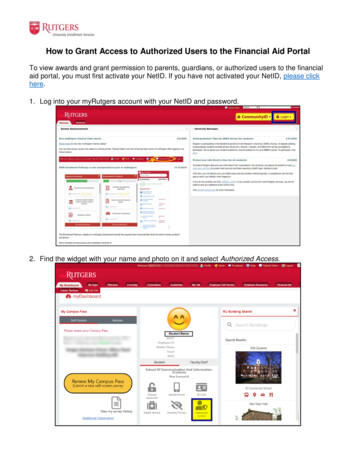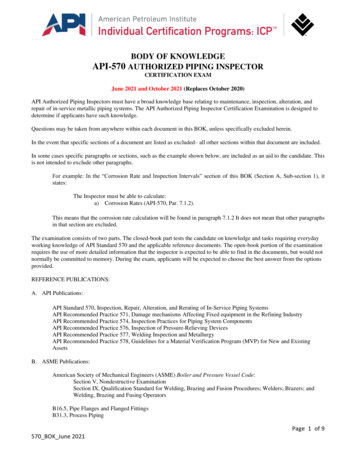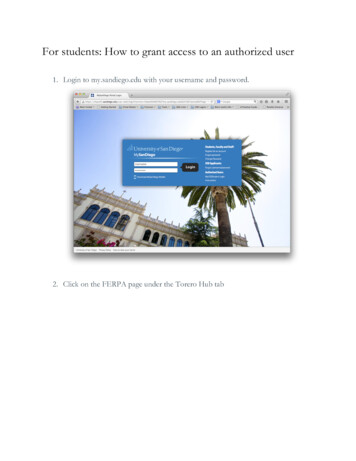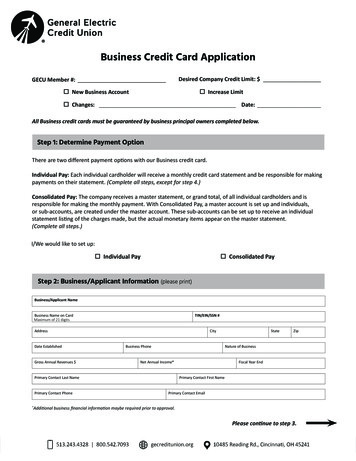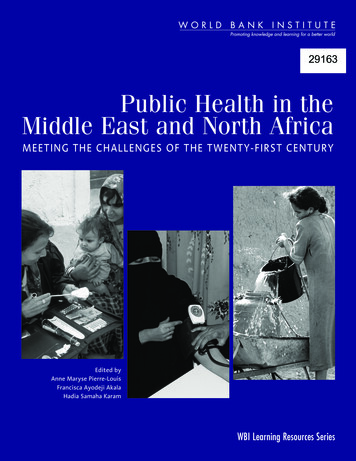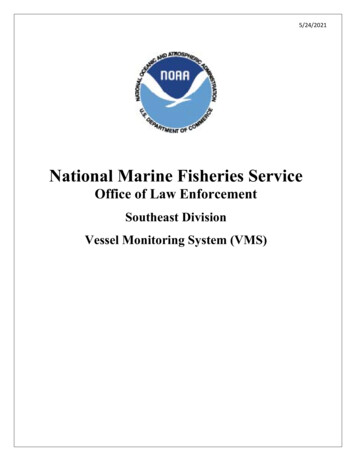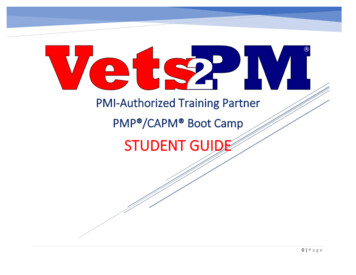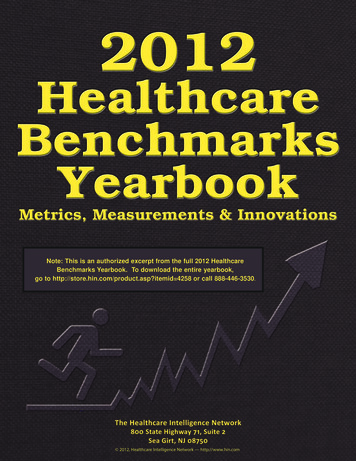
Transcription
Note: This is an authorized excerpt from the full 2012 HealthcareBenchmarks Yearbook. To download the entire yearbook,go to http://store.hin.com/product.asp?itemid 4258 or call 888-446-3530. 2012, Healthcare Intelligence Network — http://www.hin.com.Download the 2012 Healthcare Benchmarks Yearbook at http://store.hin.com/product.asp?itemid 4258 2012, Healthcare Intelligence Network — http://www.hin.com
2012 HealthcareBenchmarks Yearbook:Metrics, Measurementsand InnovationsContributing SpeakersToni Cesta, PhD, RN, FAAN, senior vice president of operational efficiency andcapacity management at Lutheran Medical Center in Brooklyn, New YorkJohn Harris, principal, DGA PartnersCarolyn Holder, MSN, RN, GCNS-BC, manager of transitional care for SummaHealth SystemLaurel Karabatsos, deputy Medicaid director for Colorado Department ofHealth Care Policy and FinancingDiane Littlewood, RN, BSN, CDE, regional manager of case management forhealth services at Geisinger Health PlanGreg Mertz, senior project director for Healthcare Strategy GroupJanice Pringle, PhD, director of the program evaluation research unit at theUniversity of Pittsburgh School of MedicineJeffrey R. Ruggiero, Esq., partner in Arnold & Porter LLPCraig Samitt, MD, MBA, president and CEO of Dean Health SystemLisa Sasko, MA, MBA, CDPHP director of clinical transformationJoanne Sciandra, RN, BSN, CCM, director, case management strategicplanning, health services, Geisinger Health PlanSusan Shepard, MSN, MA, RN, CPHRM, director of patient safety educationwith The Doctors Management CompanyMark Shields, MD, MBA, senior medical director for Advocate PhysicianPartners and vice president of medical management for Advocate Health CareNeal Sofian, MSPH, director of member engagement at Premera Blue CrossGregory Spencer, chief medical officer of Crystal Run HealthcareSteven Valentine, president, The Camden Group 2012, Healthcare Intelligence Network — http://www.hin.com.Download the 2012 Healthcare Benchmarks Yearbook at http://store.hin.com/product.asp?itemid 4258i
Executive EditorMelanie MatthewsHIN Executive Vice President and Chief Operating OfficerProject EditorsPatricia DonovanJessica PapayCover DesignJane Salmon 2012, Healthcare Intelligence Network — http://www.hin.com.Download the 2012 Healthcare Benchmarks Yearbook at http://store.hin.com/product.asp?itemid 4258
Table of ContentsNote from the Executive Editor. 19Chapter 1: Healthcare Trends for 2012Reacting to Healthcare Reform.1-5Physician-Hospital Integration 1-6Physicians Major Movers and Shakers 1-7Advice: Capture the Population 1-8CMS Medicare Bundled Payments 1-9Pilots in Comprehensive Primary Care 1-10Trends in Physician Alignment 1-11Checklist for Health IT 1-13The Physician Perspective 1-13What Younger Physicians Think 1-14Q&A: Ask the Experts. 1-16Glossary. 1-21For More Information. 1-22About the Speaker. 1-23Chapter 2: Tobacco Cessation and PreventionExecutive Summary.2-1Survey Highlights 2-2Key Findings.2-3Identifying Populations for Tobacco Cessation Programs 2-3Reimbursement and ROI 2-3Program Incentives 2-3Comparison of Year-Over-Year Data.2-4Methodology.2-7Respondent Demographics.2-7Analysis of Responses.2-8Overview of Survey Results 2-8Comparing Responses of Top 4 Sectors. 2-10The Hospital/Health System Perspective 2-12The Health Plan Perspective 2-12The Employer Perspective 2-12The Wellness Perspective 2-13Respondents in Their Own Words. 2-14Goals and Components of Future Tobacco Cessation Programs. 2-14Most Successful Tobacco Cessation Strategy. 2-14Addressing Relapses. 2-15 2012, Healthcare Intelligence Network — http://www.hin.com.Download the 2012 Healthcare Benchmarks Yearbook at http://store.hin.com/product.asp?itemid 4258iii
Conclusion. 2-16Responses to Questions. 2-172:01: Offering Tobacco Cessation Program. 2-172:02: Plan to Offer Tobacco Cessation Program. 2-182:03: Barriers to Program Launch. 2-182:04: Targeted Population. 2-192:05: Program Eligibility. 2-192:06: Participant Identification Method. 2-202:07: Program Delivery Formats. 2-202:08: When to Offer Tobacco Cessation Advice. 2-212:09: Primary Program Facilitator. 2-212:10: Length of Program Enrollment. 2-222:11: Program Components. 2-222:12: Reimbursement. 2-232:13: Measuring ROI . 2-232:14: Quit Rate Achievements. 2-242:15: Program ROI. 2-242:16: Provider Incentives. 2-252:17: Discounts Health Premiums for Non-Smokers. 2-252:18: Incentives for Quitting/Remaining Smoke-Free. 2-262:19: Disincentives/Penalties. 2-262:20: Adopted Smoke-Free Policy. 2-272:21: Organization Type. 2-272010 Tobacco Cessation and Prevention Survey Tool. 2-28Chapter 3: Reducing ReadmissionsExecutive Summary.3-1Survey Highlights 3-2Key Findings.3-2Prevalence and Targets of Readmission Reduction Programs 3-2Program Strategies and Tools 3-3Impact and ROI 3-3Methodology.3-4Respondent Demographics.3-4Analysis of Responses.3-4Overview of Survey 3-4Continued Emphasis on Hospital Discharge 3-6New Challenge for 2010: Health Literacy a Top Barrier 3-7The Hospital Perspective 3-8The Long-Term Care Perspective 3-9 2012, Healthcare Intelligence Network — http://www.hin.com.Download the 2012 Healthcare Benchmarks Yearbook at http://store.hin.com/product.asp?itemid 4258iv
Future Programs 3-10Comparison of 2009 Data to 2010 Data. 3-11Respondents in Their Own Words. 3-12Most Effective Readmission Reduction Strategy. 3-12Additional Comments on Reducing Hospital Readmissions. 3-14Conclusion. 3-15Responses to Questions. 3-16Part I: Overall Survey Responses. 3-163:1: Respondents with Programs to Reduce Readmissions. 3-163:2: Targeted Populations. 3-173:3: Targeted Conditions. 3-173:4: Patient Identification Tools. 3-183:5: Readmission Prevention Strategies. 3-183:6: Steps Performed at Hospital Discharge. 3-193:7: Primary Program Responsibility. 3-193:8: Program-Related Reduction in Hospital Readmissions. 3-203:9: Program ROI. 3-203:10: Reduced Payment for 30-Day Readmissions. 3-213:11: Barriers to Reducing Readmission Rates. 3-213:12: Planning Program in Next 12 Months. 3-223:13: No Program: Barrier to Program Launch. 3-23Part II: Responses from Hospitals. 3-243:14: Respondent Demographics. 3-243:15: Hospitals: Targeted Populations. 3-243:16: Hospitals: Targeted Conditions. 3-253:17: Hospitals: Patient Identification Tools. 3-253:18: Hospitals: Readmission Prevention Strategies. 3-263:19: Hospitals: Steps Performed at Hospital Discharge. 3-263:20: Hospitals: Primary Program Responsibility. 3-273:21: Hospitals: Reduction in Hospital Readmissions. 3-273:22: Hospitals: Program ROI. 3-283:23: Hospitals: Reduced Payment for 30-Day Readmissions. 3-28Part III: Responses from Long-Term Care. 3-293:24: Hospitals: Barriers to Reducing Readmissions. 3-293:25: Long-term Care: Targeted Populations. 3-293:26: Long-term Care: Targeted Conditions. 3-303:27: Long-term Care: Patient Identification Tools. 3-303:28: Long-term Care: Readmission Prevention Strategies. 3-313:29: Long-term Care: Steps Performed at Discharge. 3-313:30: Long-term Care: Primary Program Responsibility. 3-323:31: Long-term Care: Reduction in Hospital Readmissions. 3-32 2012, Healthcare Intelligence Network — http://www.hin.com.Download the 2012 Healthcare Benchmarks Yearbook at http://store.hin.com/product.asp?itemid 4258v
3:32: Long-term Care: Program ROI. 3-333:33: Longterm Care: Reduced Payment for 30-Day Readmissions. 3-333:34: Longterm Care: Barriers to Reducing Readmissions. 3-34Glossary. 3-35Reducing Hospital Readmissions Benchmark Survey Tool. 3-36About the Speakers. 3-40Chapter 4: Healthcare Case ManagementExecutive Summary.4-12011 Survey Highlights 4-1Key Findings.4-2Case Management Program Details 4-2Case Management Results and ROI 4-2Methodology.4-3Respondent Demographics.4-3Comparison of 2010 Data to 2011 Data.4-4Analysis of 2011 Responses.4-6Overview of Survey 4-6The Health Plan Perspective 4-7The Hospital Perspective 4-7Respondents in Their Own Words.4-9Key Case Manager Responsibility: Health Plans.4-9Key Case Manager Responsibility: Hospitals.4-9Successful Interventions and Partnerships: Health Plans. 4-10Successful Interventions and Partnerships: Hospitals. 4-11Program Success Factors: Health Plans. 4-12Program Success Factors: Hospitals. 4-12Key Contribution of the Case Manager: Health Plans. 4-13Key Contribution of the Case Manager: Hospitals. 4-14Planned Program Expansions: Health Plans. 4-15Planned Program Expansions: Hospitals. 4-15Conclusion. 4-16Responses to Questions. 4-17Part I: Overall Survey Responses. 4-174:01: Utilizing Case Managers. 4-174:02: Adding Case Managers in the Next 12 Months. 4-184:03: Populations Targeted by Case Managers. 4-184:04: Case Manager Work Locations. 4-194:05: Participant Referral Methods. 4-194:06: Average Monthly Case Load. 4-204:07: Case Manager Duties. 4-20 2012, Healthcare Intelligence Network — http://www.hin.com.Download the 2012 Healthcare Benchmarks Yearbook at http://store.hin.com/product.asp?itemid 4258vi
4:08: Case Manager Communication Tools. 4-214:09: Case Manager Educational Background. 4-214:10: Evaluating Case Manager Performance. 4-224:11: Diagnosis Most Impacted by Case Management. 4-224:12: Impact of Case Management. 4-234:13: Case Management ROI. 4-23Part II: Responses from Health Plans . 4-244:14: Respondent Organization Type. 4-244:15: Health Plans: Utilizing Case Managers. 4-244:16: Health Plans: Populations Targeted by Case Managers. 4-254:17: Health Plans - Case Manager Work Locations. 4-254:18: Health Plans - Participant Referral Methods. 4-264:19: Health Plans - Average Monthly Case Load. 4-264:20: Health Plans - Case Manager Duties. 4-274:21: Health Plans - Case Manager Communication Tools. 4-274:22: Health Plans - Case Manager Educational Background . 4-284:23: Health Plans - Evaluating Case Manager Performance . 4-284:24: Health Plans - Diagnosis Most Impacted by Case Management . 4-294:25: Health Plans - Impact of Case Management. 4-29Part III: Responses from Hospitals. 4-304:26: Health Plans - Case Management ROI. 4-304:27: Hospitals - Utilizing Case Managers . 4-304:28: Hospitals - Populations Targeted by Case Managers . 4-314:29: Hospitals - Case Manager Work Locations . 4-314:30: Hospitals - Participant Referral Methods. 4-324:31: Hospitals - Average Monthly Case Load. 4-324:32: Hospitals - Case Manager Duties . 4-334:33: Hospitals - Case Manager Communication Tools . 4-334:34: Hospitals - Case Manager Educational Background. 4-344:35: Hospitals - Evaluating Case Manager Performance. 4-344:36: Hospitals - Diagnosis Most Impacted by Case Management. 4-354:37: Hospitals - Impact of Case Management. 4-354:38: Hospitals - Case Management ROI. 4-36Glossary. 4-372011 Healthcare Case Management Benchmark Survey Tool. 4-38About the Speaker. 4-42 2012, Healthcare Intelligence Network — http://www.hin.com.Download the 2012 Healthcare Benchmarks Yearbook at http://store.hin.com/product.asp?itemid 4258vii
Chapter 5: Accountable Care OrganizationsExecutive Summary.5-7Survey Highlights 5-7Key Findings.5-8Metrics from Current ACOs 5-8Metrics from Future ACOs 5-8Methodology.5-9Respondent Demographics.5-9Analysis of Responses. 5-10Sector-Specific Survey Responses 5-11Perspectives from ‘Other’ Organizations 5-13The Hospital Perspective 5-14The Health Plan Perspective 5-15Future ACOs 5-15No Plans for an ACO 5-16Conclusion. 5-17Getting Started with ACOs: Weighing All the Opportunities. 5-18Responses to Questions. 5-25Part I: Overall Survey Responses. 5-255:01: Familiarity with ACOs. 5-255:02: Participating in an ACO. 5-265:03: Current ACOs - ACO Administrator. 5-265:04: Current ACOs - Number of Physicians in ACO. 5-275:05: Current ACOs - Types of Providers in ACO . 5-275:06: Current ACOs - Will Participate in CMS Shared Savings. 5-285:07: Current ACOs - Participating Populations . 5-285:08: Current ACOs - Number of Lives in ACO. 5-295:09: Current ACOs - Time Required to Create ACO. 5-295:10: Current ACOs - Using Electronic Health Records. 5-305:11: Current ACOs - Reimbursement Models. 5-305:12: Current ACOs - Program Success Metrics. 5-315:13: Current ACOs - Quality, Efficiency & Satisfaction Measures . 5-315:14: Future ACOs - Launching ACO in Coming Year. 5-325:15: Future ACOs - ACO Administrator . 5-335:16: Future ACOs - Number of Physicians in ACO. 5-335:17: Future ACOs - Types of Providers in ACO . 5-345:18: Future ACOs - Will Participate in CMS Shared Savings. 5-345:19: Future ACOs - Biggest Challenge of ACO Creation . 5-355:20: No Plans for ACO - Biggest Program Barrier. 5-355:21: Respondent Demographics. 5-365:22: Respondents’ Geographical Location. 5-36 2012, Healthcare Intelligen
, MSN, RN, GCNS-BC, manager of transitional care for Summa Health System Laurel Karabatsos, deputy Medicaid director for Colorado Department of . Health Care Policy and Financing Diane Littlewood, RN, BSN, CDE, regional manager of case management for health services at Geisinger Health Plan

